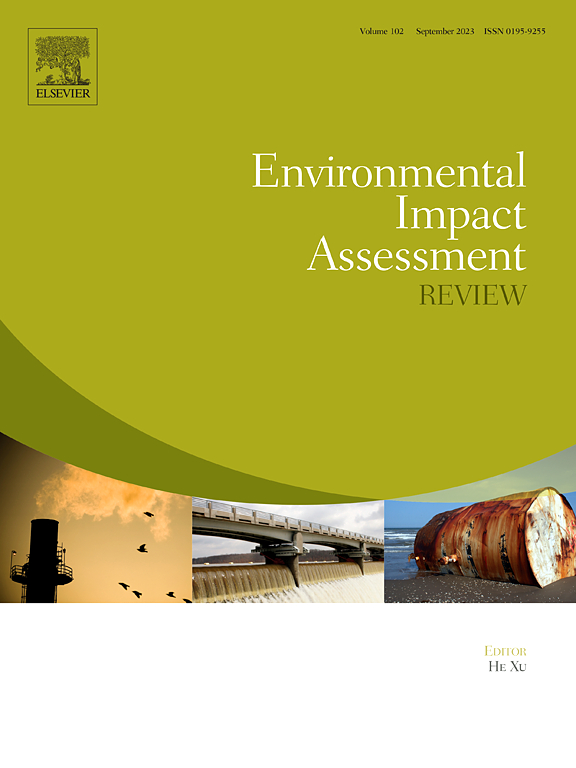一个基于物种的区域累积效应评估的灵活框架,以支持海上风能的规划和管理
IF 9.8
1区 社会学
Q1 ENVIRONMENTAL STUDIES
引用次数: 0
摘要
海上风能开发是可再生能源转型和气候适应的关键。然而,由于人类活动和自然过程的累积效应,这些活动可能对野生动物产生负面影响。在区域评估、选址和选址评估阶段,累积影响评估(CEAs)对于知情规划和管理欠发达国家的活动至关重要。为减少对野生动物的影响,露天建筑应设在避免或尽量减少土木工程的地区。我们提出了一个灵活的、以物种为基础的框架来评估来自欠欠活动和其他压力的环境绩效,支持早期规划阶段的决策。该框架采用以物种为基础的方法,适用于各种野生动物受体(即物种或种群),并根据生态学、社会经济学和压力方面的现有信息进行调整。分析策略使用CE度量来指示所有压力对受体的影响的存在或大小。空间显式优化方法确定了最小化CE度量的站点配置。该框架可容纳包括可预见的未来人类活动和自然过程在内的各种压力情景,并可探索结果对不确定参数的敏感性。给定足够的受体密度、压力大小和因果路径的空间信息,空间优化算法可以找到最小化物种或种群水平的CE影响的解决方案。如果由于信息差距而无法实现理想的标准,则可以使用替代度量来通知即时决策过程。该框架为平衡可再生能源目标与野生动物保护提供了一种实用的方法,即使信息不完整。本文章由计算机程序翻译,如有差异,请以英文原文为准。
A flexible framework for species-based regional cumulative effects assessments to support offshore wind energy planning and management
Offshore wind energy development (OWED) is pivotal for renewable energy transition and climate resiliency. However, OWED activities may negatively affect wildlife, contributing to cumulative effects (CE) from human activities and natural processes. Cumulative effects assessments (CEAs) are vital for informed planning and management of OWED activities during regional assessment, site selection, and site evaluation phases. To reduce impacts on wildlife, OWEDs should be sited in areas that avoid or minimize CE. We present a flexible, species-based framework to assess CE from OWED activities and other pressures, supporting decision-making in early planning phases. The framework uses a species-based approach, applicable to various wildlife receptors (i.e., species or populations), and adapts to available information on ecology, socioeconomics, and pressures. The analytical strategy uses a CE metric to indicate the presence or magnitude of effects from all pressures on receptors. Spatially explicit optimization methods identify OWED site configurations that minimize a CE metric. The framework accommodates alternative pressure scenarios that include foreseeable future human activities and natural processes and can explore the sensitivity of the results to uncertain parameters. Given sufficient spatial information on receptor density, pressure magnitude, and cause-effect pathways, the spatial optimization algorithm can find solutions that minimize species- or population-level impacts from CE. If this ideal standard cannot be achieved due to information gaps, alternative metrics may be used to inform the immediate decision-making process. This framework offers a practical approach for balancing renewable energy goals with wildlife conservation, even when information is incomplete.
求助全文
通过发布文献求助,成功后即可免费获取论文全文。
去求助
来源期刊

Environmental Impact Assessment Review
ENVIRONMENTAL STUDIES-
CiteScore
12.60
自引率
10.10%
发文量
200
审稿时长
33 days
期刊介绍:
Environmental Impact Assessment Review is an interdisciplinary journal that serves a global audience of practitioners, policymakers, and academics involved in assessing the environmental impact of policies, projects, processes, and products. The journal focuses on innovative theory and practice in environmental impact assessment (EIA). Papers are expected to present innovative ideas, be topical, and coherent. The journal emphasizes concepts, methods, techniques, approaches, and systems related to EIA theory and practice.
 求助内容:
求助内容: 应助结果提醒方式:
应助结果提醒方式:


